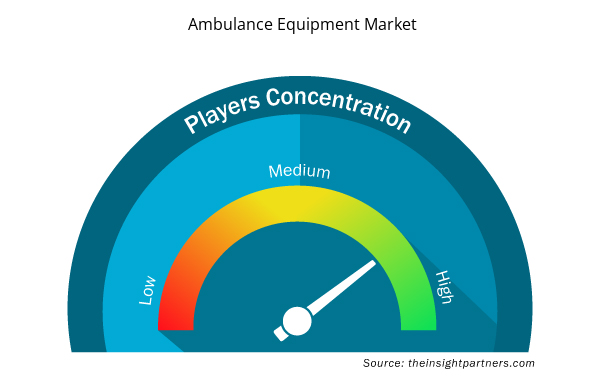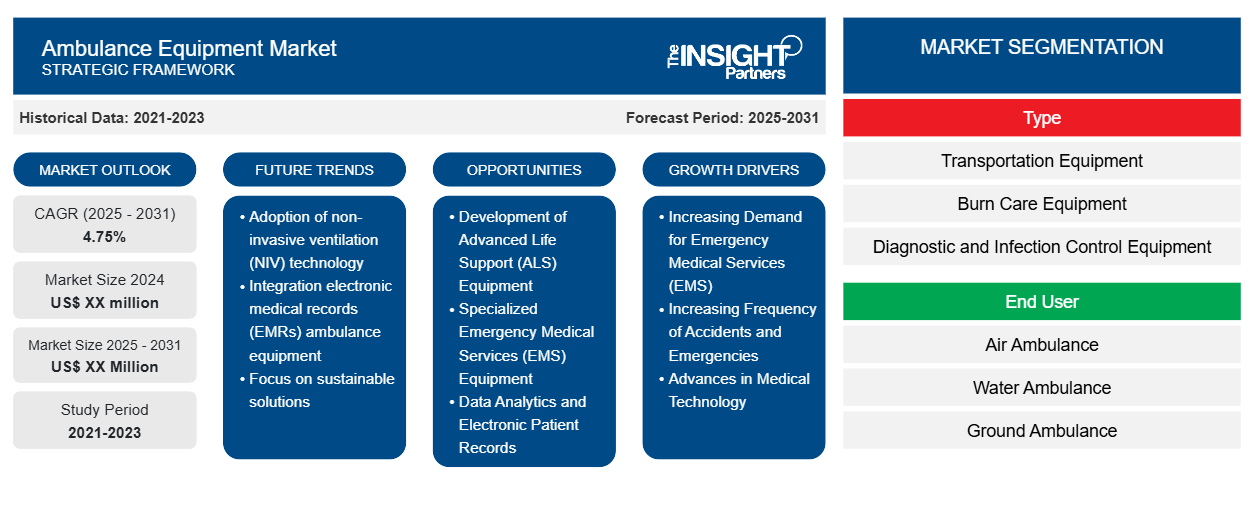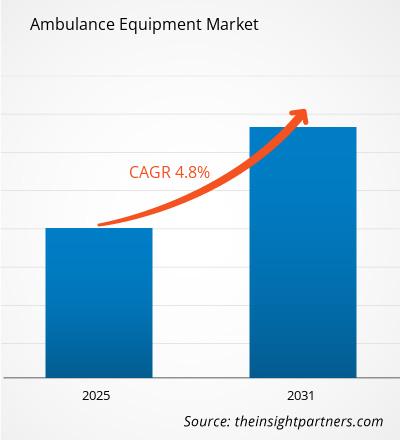Si prevede che il mercato delle attrezzature per ambulanze registrerà un CAGR del 4,75% dal 2024 al 2031, con una dimensione di mercato in espansione da XX milioni di dollari nel 2024 a XX milioni di dollari entro il 2031.
Il report è suddiviso in base a Tipo (Attrezzature per il trasporto, Attrezzature per la cura delle ustioni, Attrezzature per la diagnosi e il controllo delle infezioni, Attrezzature per il controllo del sangue e delle emorragie, Attrezzature respiratorie, ipotermia e cardiache), Utente finale (Ambulanza aerea, Ambulanza idrica e Ambulanza terrestre). L'analisi globale è ulteriormente suddivisa a livello regionale e nei principali paesi. Il report offre il valore in USD per l'analisi e i segmenti di cui sopra.
Scopo del rapporto
Il report Ambulance Equipment Market di The Insight Partners mira a descrivere il panorama attuale e la crescita futura, i principali fattori trainanti, le sfide e le opportunità. Ciò fornirà spunti a vari stakeholder aziendali, come:
- Fornitori/produttori di tecnologia: per comprendere le dinamiche di mercato in evoluzione e conoscere le potenziali opportunità di crescita, consentendo loro di prendere decisioni strategiche informate.
- Investitori: condurre un'analisi completa delle tendenze relative al tasso di crescita del mercato, alle proiezioni finanziarie del mercato e alle opportunità esistenti lungo la catena del valore.
- Enti di regolamentazione: regolamentano le politiche e le attività di controllo sul mercato allo scopo di ridurre al minimo gli abusi, preservare la fiducia degli investitori e sostenere l'integrità e la stabilità del mercato.
Segmentazione del mercato delle attrezzature per ambulanze
Tipo
- Attrezzature per il trasporto
- Attrezzatura per la cura delle ustioni
- Apparecchiature per la diagnosi e il controllo delle infezioni
- Attrezzature per il controllo del sangue e delle emorragie
- Respiratorio
- Ipotermia
- Attrezzatura cardiaca
Utente finale
- Ambulanza aerea
- Ambulanza dell'acqua
- Ambulanza terrestre
Personalizza questo report in base alle tue esigenze
Riceverai la personalizzazione gratuita di qualsiasi report, comprese parti di questo report, o analisi a livello nazionale, pacchetto dati Excel, oltre a usufruire di grandi offerte e sconti per start-up e università
- Scopri le principali tendenze di mercato in questo rapporto.Questo campione GRATUITO includerà analisi di dati che spaziano dalle tendenze di mercato alle stime e alle previsioni.
Fattori trainanti della crescita del mercato delle attrezzature per ambulanze
- Domanda crescente di servizi medici di emergenza (EMS): la crescita della popolazione mondiale, così come l'urbanizzazione e la crescente consapevolezza di un'adeguata accessibilità al trattamento hanno portato a una domanda crescente di servizi medici di emergenza (EMS). Di conseguenza, questo espande anche il mercato dei dispositivi correlati al trasporto Medicare come barelle, sedie a rotelle, dispositivi per ossigenoterapia o qualsiasi altra attrezzatura.
- Aumento della frequenza di incidenti ed emergenze: l'aumento dei casi di incidenti e/o emergenze sta anche facendo aumentare la necessità di attrezzature per ambulanze, date le circostanze. L'aumento del numero di incidenti ed emergenze crea una maggiore necessità di fornitura di servizi medici di emergenza, da cui l'aumento della richiesta di attrezzature per ambulanze.
- Progressi nella tecnologia medica: con la crescita della tecnologia che circonda il campo medico, aumentano anche la qualità e la complessità degli strumenti per ambulanze sul mercato. Ad esempio, sono state inventate unità mobili di terapia intensiva (MICU) e ambulanze per terapia intensiva, consentendo agli operatori sanitari di offrire servizi migliori ai pazienti in transito.
Tendenze future del mercato delle attrezzature per ambulanze
- Adozione della tecnologia di ventilazione non invasiva (NIV): molti medici ritengono che l'attrezzatura per la ventilazione non invasiva (NIV) sia un importante sviluppo progressivo. Può fornire un trattamento salvavita con ossigeno senza inserire tubi nella trachea. I fornitori di attrezzature per ambulanze stanno sviluppando dispositivi NIV leggeri, portatili e facili da usare
- Integrazione di cartelle cliniche elettroniche (EMR) nell'attrezzatura dell'ambulanza: l'integrazione dei sistemi di cartelle cliniche elettroniche (EMR) nell'attrezzatura dell'ambulanza è aumentata in modo significativo. L'attrezzatura dell'ambulanza integrata con EMR consente uno scambio di dati senza interruzioni e migliora la qualità dell'assistenza ai pazienti, fornendo ai fornitori un accesso immediato alle informazioni sui pazienti durante il servizio, senza inutili ritardi.
- Attenzione alle soluzioni sostenibili: c'è anche una crescente enfasi sull'aspetto ecologico nel mercato delle attrezzature per ambulanze, poiché la preoccupazione principale rimane la sostenibilità ambientale e i risparmi sui costi associati. Le aziende stanno progettando prodotti "più puliti" che risparmiano energia e sono ecosostenibili.
Opportunità di mercato per le attrezzature delle ambulanze
- Sviluppo di apparecchiature di supporto vitale avanzato (ALS): la domanda di apparecchiature di supporto vitale avanzato (ALS), come defibrillatori generici, ventilatori, pompe per infusione, ecc., è destinata ad aumentare a causa dell'aumento delle chiamate ai servizi medici di emergenza (EMS) e della necessità di opzioni di trattamento più pesanti. Con la crescita dell'approccio consapevole all'assistenza sanitaria, è possibile per gli operatori del mercato concentrarsi sul potenziamento dell'attuale gamma di prodotti o sulla progettazione di nuovi prodotti con migliori capacità salvavita.
- Attrezzature per servizi medici di emergenza specializzati (EMS): l'esplorazione dei requisiti dell'acquirente, in relazione all'acquisto di attrezzature mediche specializzate, quelle destinate a: ventilatori, defibrillatori, apparecchi di aspirazione, ecc., è associata a AEBS ottimistici per produttori o venditori.
- Analisi dei dati e cartelle cliniche elettroniche: Analisi dei dati e cartelle cliniche elettroniche: Con l'aumento dell'analisi dei dati e dell'utilizzo delle cartelle cliniche elettroniche all'interno delle strutture sanitarie, esiste una strada per gli operatori del mercato per progettare e creare adattamenti di software con le attrezzature delle ambulanze per migliorare l'assistenza ai pazienti
Approfondimenti regionali sul mercato delle attrezzature per ambulanze
Le tendenze regionali e i fattori che influenzano il mercato delle attrezzature per ambulanze durante il periodo di previsione sono stati ampiamente spiegati dagli analisti di Insight Partners. Questa sezione discute anche i segmenti e la geografia del mercato delle attrezzature per ambulanze in Nord America, Europa, Asia Pacifico, Medio Oriente e Africa e Sud e Centro America.

- Ottieni i dati specifici regionali per il mercato delle attrezzature per ambulanze
Ambito del rapporto sul mercato delle attrezzature per ambulanze
| Attributo del report | Dettagli |
|---|---|
| Dimensioni del mercato nel 2024 | XX milioni di dollari USA |
| Dimensioni del mercato entro il 2031 | XX milioni di dollari USA |
| CAGR globale (2024 - 2031) | 4,75% |
| Dati storici | 2021-2023 |
| Periodo di previsione | 2025-2031 |
| Segmenti coperti | Per tipo
|
| Regioni e Paesi coperti | America del Nord
|
| Leader di mercato e profili aziendali chiave |
|
Densità degli operatori del mercato delle attrezzature per ambulanze: comprendere il suo impatto sulle dinamiche aziendali
Il mercato delle attrezzature per ambulanze sta crescendo rapidamente, spinto dalla crescente domanda degli utenti finali dovuta a fattori quali l'evoluzione delle preferenze dei consumatori, i progressi tecnologici e una maggiore consapevolezza dei vantaggi del prodotto. Con l'aumento della domanda, le aziende stanno ampliando le loro offerte, innovando per soddisfare le esigenze dei consumatori e capitalizzando sulle tendenze emergenti, il che alimenta ulteriormente la crescita del mercato.
La densità degli operatori di mercato si riferisce alla distribuzione di aziende o società che operano in un particolare mercato o settore. Indica quanti concorrenti (operatori di mercato) sono presenti in un dato spazio di mercato in relazione alle sue dimensioni o al valore di mercato totale.
Le principali aziende che operano nel mercato delle attrezzature per ambulanze sono:
- 3 milioni
- Sistemi BLS limitati
- Medtronic
- Elettrico generale
- Stryker
Disclaimer : le aziende elencate sopra non sono classificate secondo un ordine particolare.

- Ottieni una panoramica dei principali attori del mercato delle attrezzature per ambulanze
Punti di forza chiave
- Copertura completa: il rapporto esamina in modo completo i prodotti, i servizi, le tipologie e gli utenti finali del mercato delle attrezzature per ambulanze, fornendo una panoramica olistica.
- Analisi degli esperti: il rapporto è compilato sulla base della conoscenza approfondita di esperti e analisti del settore.
- Informazioni aggiornate: il rapporto garantisce la pertinenza aziendale grazie alla copertura di informazioni recenti e tendenze nei dati.
- Opzioni di personalizzazione: questo report può essere personalizzato per soddisfare le esigenze specifiche del cliente e adattarsi in modo appropriato alle strategie aziendali.
Il rapporto di ricerca sul mercato delle attrezzature per ambulanze può, quindi, aiutare a guidare il percorso di decodifica e comprensione dello scenario del settore e delle prospettive di crescita. Sebbene possano esserci alcune preoccupazioni valide, i vantaggi complessivi di questo rapporto tendono a superare gli svantaggi.
- Analisi storica (2 anni), anno base, previsione (7 anni) con CAGR
- Analisi PEST e SWOT
- Valore/volume delle dimensioni del mercato - Globale, regionale, nazionale
- Industria e panorama competitivo
- Set di dati Excel



Report Coverage
Revenue forecast, Company Analysis, Industry landscape, Growth factors, and Trends

Segment Covered
This text is related
to segments covered.

Regional Scope
North America, Europe, Asia Pacific, Middle East & Africa, South & Central America

Country Scope
This text is related
to country scope.
Domande frequenti
The ambulance equipment market is estimated to grow with a CAGR of 4.7% from 2023 to 2031.
Asia Pacific region is likely to witness fastest growth rate during the forecast period.
The market drivers include Increasing Demand for Emergency Medical Services (EMS) and Increasing Frequency of Accidents and Emergencies are driving the ambulance equipment market
The ambulance equipment market majorly consists of the players such as Allied Healthcare Products, Inc., BLS Systems, Ltd., GE Healthcar among others.
Integration electronic medical records (EMRs) ambulance equipment is likely to remain the key trend during the forecast period
North America dominated the ambulance equipment market in 2023
Trends and growth analysis reports related to Life Sciences : READ MORE..
1. 3M
2. BLS Systems Limited
3. Medtronic
4. General Electric
5. Stryker
6. Allied Healthcare Products, Inc.
7. Drägerwerk AG & Co. KGaA
8. Ambu A/S
9. Emergency Medical International
10. PerSys Medical
The Insight Partners performs research in 4 major stages: Data Collection & Secondary Research, Primary Research, Data Analysis and Data Triangulation & Final Review.
- Data Collection and Secondary Research:
As a market research and consulting firm operating from a decade, we have published and advised several client across the globe. First step for any study will start with an assessment of currently available data and insights from existing reports. Further, historical and current market information is collected from Investor Presentations, Annual Reports, SEC Filings, etc., and other information related to company’s performance and market positioning are gathered from Paid Databases (Factiva, Hoovers, and Reuters) and various other publications available in public domain.
Several associations trade associates, technical forums, institutes, societies and organization are accessed to gain technical as well as market related insights through their publications such as research papers, blogs and press releases related to the studies are referred to get cues about the market. Further, white papers, journals, magazines, and other news articles published in last 3 years are scrutinized and analyzed to understand the current market trends.
- Primary Research:
The primarily interview analysis comprise of data obtained from industry participants interview and answers to survey questions gathered by in-house primary team.
For primary research, interviews are conducted with industry experts/CEOs/Marketing Managers/VPs/Subject Matter Experts from both demand and supply side to get a 360-degree view of the market. The primary team conducts several interviews based on the complexity of the markets to understand the various market trends and dynamics which makes research more credible and precise.
A typical research interview fulfils the following functions:
- Provides first-hand information on the market size, market trends, growth trends, competitive landscape, and outlook
- Validates and strengthens in-house secondary research findings
- Develops the analysis team’s expertise and market understanding
Primary research involves email interactions and telephone interviews for each market, category, segment, and sub-segment across geographies. The participants who typically take part in such a process include, but are not limited to:
- Industry participants: VPs, business development managers, market intelligence managers and national sales managers
- Outside experts: Valuation experts, research analysts and key opinion leaders specializing in the electronics and semiconductor industry.
Below is the breakup of our primary respondents by company, designation, and region:

Once we receive the confirmation from primary research sources or primary respondents, we finalize the base year market estimation and forecast the data as per the macroeconomic and microeconomic factors assessed during data collection.
- Data Analysis:
Once data is validated through both secondary as well as primary respondents, we finalize the market estimations by hypothesis formulation and factor analysis at regional and country level.
- Macro-Economic Factor Analysis:
We analyse macroeconomic indicators such the gross domestic product (GDP), increase in the demand for goods and services across industries, technological advancement, regional economic growth, governmental policies, the influence of COVID-19, PEST analysis, and other aspects. This analysis aids in setting benchmarks for various nations/regions and approximating market splits. Additionally, the general trend of the aforementioned components aid in determining the market's development possibilities.
- Country Level Data:
Various factors that are especially aligned to the country are taken into account to determine the market size for a certain area and country, including the presence of vendors, such as headquarters and offices, the country's GDP, demand patterns, and industry growth. To comprehend the market dynamics for the nation, a number of growth variables, inhibitors, application areas, and current market trends are researched. The aforementioned elements aid in determining the country's overall market's growth potential.
- Company Profile:
The “Table of Contents” is formulated by listing and analyzing more than 25 - 30 companies operating in the market ecosystem across geographies. However, we profile only 10 companies as a standard practice in our syndicate reports. These 10 companies comprise leading, emerging, and regional players. Nonetheless, our analysis is not restricted to the 10 listed companies, we also analyze other companies present in the market to develop a holistic view and understand the prevailing trends. The “Company Profiles” section in the report covers key facts, business description, products & services, financial information, SWOT analysis, and key developments. The financial information presented is extracted from the annual reports and official documents of the publicly listed companies. Upon collecting the information for the sections of respective companies, we verify them via various primary sources and then compile the data in respective company profiles. The company level information helps us in deriving the base number as well as in forecasting the market size.
- Developing Base Number:
Aggregation of sales statistics (2020-2022) and macro-economic factor, and other secondary and primary research insights are utilized to arrive at base number and related market shares for 2022. The data gaps are identified in this step and relevant market data is analyzed, collected from paid primary interviews or databases. On finalizing the base year market size, forecasts are developed on the basis of macro-economic, industry and market growth factors and company level analysis.
- Data Triangulation and Final Review:
The market findings and base year market size calculations are validated from supply as well as demand side. Demand side validations are based on macro-economic factor analysis and benchmarks for respective regions and countries. In case of supply side validations, revenues of major companies are estimated (in case not available) based on industry benchmark, approximate number of employees, product portfolio, and primary interviews revenues are gathered. Further revenue from target product/service segment is assessed to avoid overshooting of market statistics. In case of heavy deviations between supply and demand side values, all thes steps are repeated to achieve synchronization.
We follow an iterative model, wherein we share our research findings with Subject Matter Experts (SME’s) and Key Opinion Leaders (KOLs) until consensus view of the market is not formulated – this model negates any drastic deviation in the opinions of experts. Only validated and universally acceptable research findings are quoted in our reports.
We have important check points that we use to validate our research findings – which we call – data triangulation, where we validate the information, we generate from secondary sources with primary interviews and then we re-validate with our internal data bases and Subject matter experts. This comprehensive model enables us to deliver high quality, reliable data in shortest possible time.


 Ottieni un campione gratuito per questo repot
Ottieni un campione gratuito per questo repot